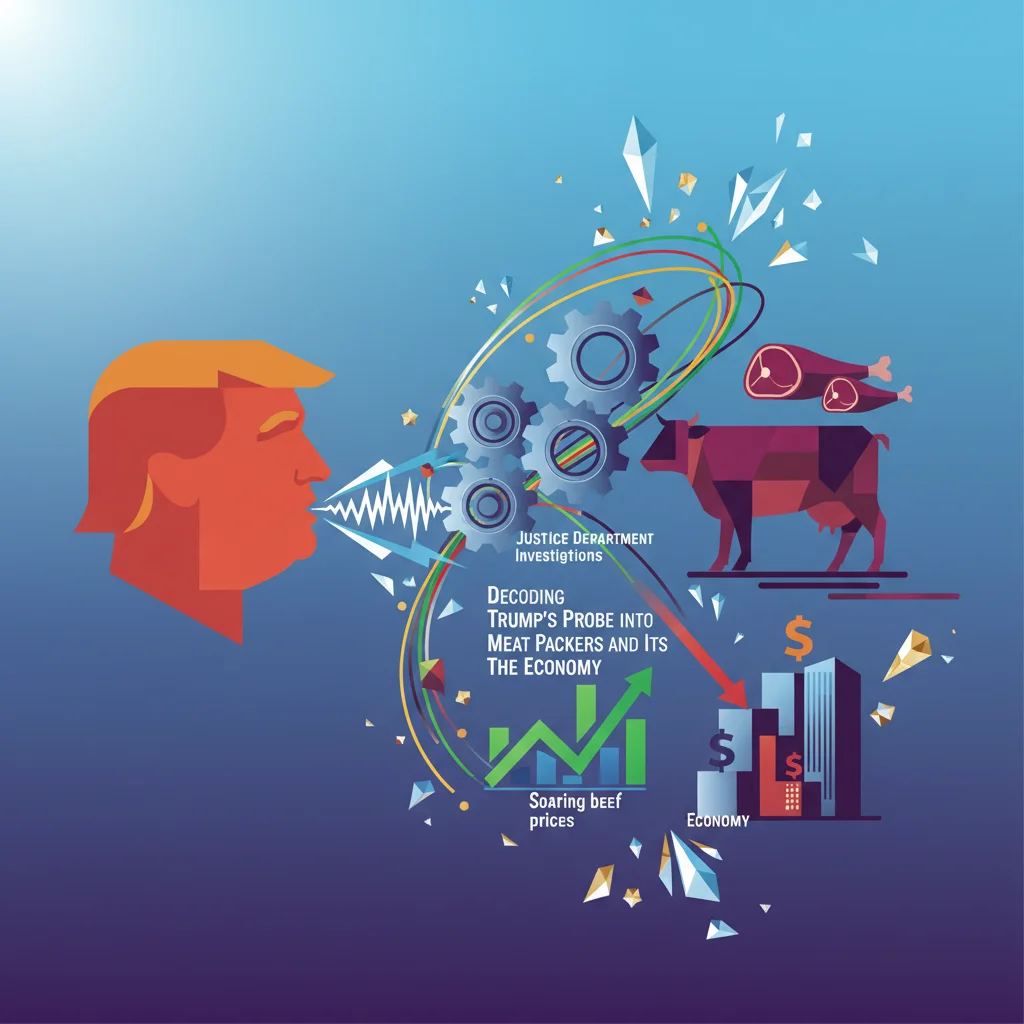
Beyond the Headlines: Decoding Trump’s Probe into Meat Packers and Its Impact on the Economy
In a move that reverberates from the farm gate to the stock market, former President Donald Trump has called on the Justice Department to investigate major meatpacking companies over soaring beef prices. While the call itself is a political headline, it spotlights a deep-seated and complex issue at the heart of the American economy: market concentration and its impact on consumers, producers, and investors. This isn’t just about the price of a steak; it’s a multi-faceted dilemma involving antitrust law, supply chain dynamics, and the very structure of a critical sector of our economy.
The core of the controversy lies in a frustrating paradox that has plagued the industry for years: while consumers at the grocery store see beef prices climb, cattle ranchers often receive prices that barely cover their costs. This widening gap between what producers are paid and what consumers pay has fueled accusations of price gouging and anticompetitive behavior by the “Big Four” meatpackers who dominate the industry. Understanding this issue requires a deep dive into the market’s structure, the financial implications for publicly traded companies, and the potential for both regulatory and technological disruption.
The Oligopoly on Your Dinner Plate: Understanding the Beef Industry’s Structure
The U.S. beef processing industry is a textbook example of an oligopoly, a market structure where a small number of firms have the large majority of market share. Four companies—Tyson Foods, JBS USA, Cargill, and National Beef Packing Co.—control over 85% of the fed-cattle market in the United States, according to White House data. This immense concentration gives them significant power over the prices they pay to ranchers for cattle and the prices they charge wholesalers and retailers for processed beef.
This market power has been the subject of scrutiny long before the recent call for a probe. The Biden administration has also targeted the issue, allocating funds to support independent processors and strengthening enforcement of the Packers and Stockyards Act. The concern is that with so few buyers, ranchers have little leverage to negotiate fair prices for their livestock. If a local processing plant is owned by one of the Big Four, a rancher’s options are severely limited, forcing them to accept the offered price or face prohibitive transportation costs to find another buyer.
This concentration didn’t happen overnight. It is the result of decades of consolidation, mergers, and acquisitions that have systematically reduced competition. From an economics perspective, this can lead to market inefficiencies and a misallocation of resources, where profits are concentrated at the processing level at the expense of both primary producers and end consumers.
The Palace and the Blockchain: A Royal Controversy and Its Lessons for Modern Investors
The Investor’s Perspective: Navigating a Politically Charged Stock Market
For those involved in investing and trading, this political and regulatory pressure creates a volatile environment. Tyson Foods (NYSE: TSN) is the most prominent publicly traded company among the Big Four, and its stock performance is often a bellwether for the sector. The threat of a Justice Department investigation, coupled with ongoing congressional scrutiny, represents a significant non-market risk for investors.
An antitrust probe could result in several outcomes, each with different implications for the stock market:
- Heavy Fines: The most direct financial impact would be substantial fines, which could eat into profits and negatively affect stock prices.
- Forced Divestitures: In a more extreme scenario, regulators could force companies to sell off certain plants or divisions to break up their market concentration and foster competition. This would fundamentally alter the company’s structure and outlook.
- Increased Regulation: New rules governing how meatpackers purchase cattle and price beef could be implemented, potentially squeezing profit margins and limiting their operational flexibility.
- Reputational Damage: A lengthy, public investigation can damage a company’s reputation, affecting its relationships with suppliers, customers, and investors.
Below is a simplified comparison illustrating the price disconnect that fuels these investigations. While actual figures fluctuate daily, this table represents the core issue: the diverging trends between the price ranchers receive and the price consumers pay.
| Market Participant | Price Trend Example (Hypothetical) | Key Economic Factors |
|---|---|---|
| Cattle Rancher (Producer) | Stagnant or declining prices for live cattle | Limited buyers, high feed/input costs, oversupply risk |
| Meat Packer (Processor) | Widening “packer spread” (profit margin) | Market concentration, economies of scale, labor costs |
| Consumer (End User) | Increasing retail prices for beef products | Inflation, retail markups, strong consumer demand |
This “packer spread” is a key metric watched by industry analysts. A report from the USDA Economic Research Service provides detailed data on these spreads, which have shown significant volatility and expansion during periods of market disruption, such as the COVID-19 pandemic. Investors must weigh the strong market position and consistent demand for products from companies like Tyson against the growing regulatory and political risks that threaten their long-standing business model.
Can Technology Break the Stranglehold? Fintech and Blockchain as Market Disruptors
While regulators focus on legal frameworks, the world of financial technology may offer more innovative, market-based solutions to the industry’s concentration problem. The core issues are a lack of transparency and an imbalance of power in the supply chain. This is precisely where technologies like blockchain and new fintech platforms could make a significant impact.
Blockchain for Supply Chain Transparency
Imagine a supply chain where every animal is tracked on an immutable digital ledger from birth to the grocery store shelf. A blockchain-based system could provide unprecedented transparency:
- Fair Pricing for Ranchers: By providing verifiable data on an animal’s history, health, and quality, ranchers could command premium prices for superior products, bypassing the opaque pricing models of the big packers.
- Trust for Consumers: Consumers could scan a QR code on a package of beef and see the entire journey of the product, verifying its origin, ethical treatment, and processing standards. This builds trust and allows smaller, high-quality producers to differentiate themselves.
- Efficient Auditing: Regulators could more easily audit the supply chain to ensure compliance with safety and competition laws, making it harder to engage in anticompetitive practices. According to a report by IBM, blockchain can significantly enhance traceability and efficiency in supply chains.
Fintech Platforms for a Decentralized Marketplace
Beyond tracking, fintech can create new marketplaces that connect producers directly with consumers or retailers, disrupting the traditional banking and financing models that favor large corporations. This could take several forms:
- Peer-to-Peer (P2P) Trading Platforms: Specialized platforms could allow ranchers to sell directly to butcher shops, restaurants, or even consumer co-ops, creating a more competitive and decentralized market.
- Crowd-Financing for Processors: One of the biggest barriers for new entrants is the high cost of building a processing facility. Fintech platforms could enable communities to crowdfund and co-own smaller, local processing plants, creating competition from the ground up.
- Smart Contracts: Automated contracts on a blockchain could execute payments to ranchers as soon as their cattle are delivered and processed, improving cash flow and reducing reliance on the payment terms dictated by large packers.
Conclusion: A Crossroads for a Critical Industry
Donald Trump’s call for an investigation is more than just a political maneuver; it’s a catalyst for a much-needed conversation about the health and fairness of the American food supply chain. The issue of meatpacker concentration touches every aspect of our economy, from the livelihood of rural farmers to the grocery bills of every family, and the portfolio risk for every investor in the food and agriculture sector.
For business leaders and finance professionals, the situation presents both a threat and an opportunity. The threat lies in the regulatory uncertainty and the potential for disruptive government intervention that could upend a century-old industry model. The opportunity, however, is immense. It lies in leveraging technology to build a more transparent, efficient, and equitable system. Whether through regulatory action, technological disruption, or a combination of both, the beef industry is at a crossroads. The path it takes will have lasting implications for the future of food, finance, and the American market itself.
The 2-Minute Gold Rush: How Micro-Dramas Are Reshaping Media and Creating New Investment Frontiers


